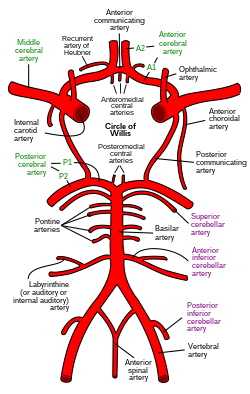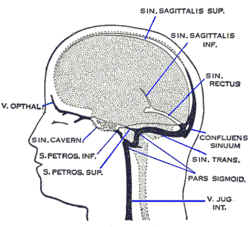Cerebral circulation
It has been suggested that Cerebral blood flow be merged into this article. (Discuss) Proposed since January 2015. |

Cerebral circulation is the movement of blood through the network of blood vessels supplying the brain. The rate of the cerebral blood flow in the adult, is typically 750 milliliters per minute, representing 15% of the cardiac output. The arteries deliver oxygenated blood, glucose and other nutrients to the brain and the veins carry deoxygenated blood back to the heart, removing carbon dioxide, lactic acid, and other metabolic products. Since the brain is very vulnerable to compromises in its blood supply, the cerebral circulatory system has many safeguards. Failure of these safeguards results in cerebrovascular accidents, commonly known as strokes. The amount of blood that the cerebral circulation carries is known as cerebral blood flow. The presence of gravitational fields or accelerations also determine variations in the movement and distribution of blood in the brain, such as when suspended upside-down.
The following description is based on idealized human cerebral circulation. The pattern of circulation and its nomenclature vary between organisms.
Arterial cerebral circulation
| Cerebral circulation | |
|---|---|
 | |
| Identifiers | |
| MeSH | D002560 |
| Anatomical terminology | |
The arterial cerebral circulation is normally divided into anterior cerebral circulation and posterior cerebral circulation. There are two main pairs of arteries that supply the cerebral arteries and the cerebrum: Internal carotid arteries and vertebral arteries.
The anterior and posterior cerebral circulations are interconnected via bilateral posterior communicating arteries. They are part of the Circle of Willis, which provides backup circulation to the brain. In case one of the supply arteries is occluded, the Circle of Willis provides interconnections between the anterior and the posterior cerebral circulation along the floor of the cerebral vault, providing blood to tissues that would otherwise become ischemic.
Anterior cerebral circulation
The anterior cerebral circulation is the blood supply to the anterior portion of the brain. It is supplied by the following arteries:
- Internal carotid arteries: These large arteries are the left and right branches of the common carotid arteries in the neck which enter the skull, as opposed to the external carotid branches which supply the facial tissues. The internal carotid artery branches into the anterior cerebral artery and continues to form the middle cerebral artery
- Anterior cerebral artery (ACA)
- Anterior communicating artery: Connects both anterior cerebral arteries, within and along the floor of the cerebral vault.
- Middle cerebral artery (MCA)
Posterior cerebral circulation
The posterior cerebral circulation is the blood supply to the posterior portion of the brain, including the occipital lobes, cerebellum and brainstem. It is supplied by the following arteries:
- Vertebral arteries: These smaller arteries branch from the subclavian arteries which primarily supply the shoulders, lateral chest and arms. Within the cranium the two vertebral arteries fuse into the basilar artery.
- Basilar artery: Supplies the midbrain, cerebellum, and usually branches into the posterior cerebral artery
- Posterior cerebral artery (PCA)
- Posterior communicating artery
Cerebral venous drainage
| Cerebral venous drainage | |
|---|---|
 Dural veins | |
| Identifiers | |
| MeSH | D002560 |
| Anatomical terminology | |
The venous drainage of the cerebrum can be separated into two subdivisions: superficial and deep.
The superficial system is composed of dural venous sinuses, which have wall composed of dura mater as opposed to a traditional vein. The dural sinuses are, therefore located on the surface of the cerebrum. The most prominent of these sinuses is the superior sagittal sinus which flows in the sagittal plane under the midline of the cerebral vault, posteriorly and inferiorly to the torcula, forming the confluence of sinuses, where the superficial drainage joins with the sinus that primarily drains the deep venous system. From here, two transverse sinuses bifurcate and travel laterally and inferiorly in an S-shaped curve that form the sigmoid sinuses which go on to form the two jugular veins. In the neck, the jugular veins parallel the upward course of the carotid arteries and drain blood into the superior vena cava.
The deep venous drainage is primarily composed of traditional veins inside the deep structures of the brain, which join behind the midbrain to form the vein of Galen. This vein merges with the inferior sagittal sinus to form the straight sinus which then joins the superficial venous system mentioned above at the confluence of sinuses.


